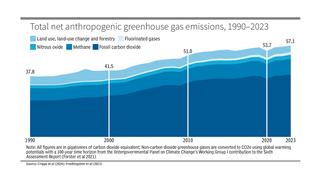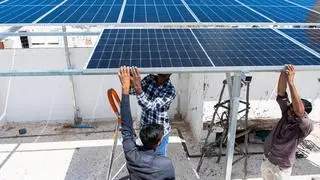The government has announced a ₹200-crore scheme for the “implementation of pilot projects for the production and use of green hydrogen using innovative methods or pathways in the residential, commercial, local community, decentralised or non-conventional applications”. Examples of such projects include floating solar-based green hydrogen production, biomass-based green hydrogen, and green hydrogen from wastewater. Decentralised use of green hydrogen could include cooking, heating, off-grid electricity generation or powering off-road vehicles, says the Ministry of New and Renewable Energy.
A government body would implement the scheme, the Ministry said. “The production of green hydrogen via different innovative models/pathways and the use of green hyrogen and its derivatives in... new sectors... will lead to the setting up of necessary facilities including refuelling stations, storage and distribution networks, resulting in the establishment of a green hydrogen ecosystem in these new sectors,” the Ministry’s document says.
Steady growth in export of solar PV products to the US
India exported solar photovoltaic products (modules and cells) worth $2 billion in 2023-24, which was 23 times more than in the previous year. India exported 5.8 GW of PV modules, three times more than in 2022-23. Almost all the exports were to the US; the bulk of the exports were from three companies — Waree, Adani and Vikram. But this is only the beginning of the story.
A recent report by the Institute for Energy Economics and Financial Analysis and JMK Research & Analytics notes that the US could be buying more from India. Already, the US is not buying directly from China, having slapped tariffs and halted buying from the Xinjiang region under the Uyghur Forced Labor Prevention Act.
In June 2022, the US enacted a free trade agreement to provide duty-free access to solar imports from Cambodia, Malaysia, Thailand and Vietnam for two years. However, in June 2024, the US clarified that solar imports from these countries would attract import tariffs. It is also investigating a complaint by the American Alliance for Solar Manufacturing Trade Committee about illegal trade practices by Southeast Asian countries. All of this could help India’s cause.
India’s battery market to remain import-dependent
India will remain dependent on imports for batteries and components, observes the International Energy Agency. In its recent Energy Technology Perspectives 2024 report, the agency notes that about 80 GWh of manufacturing capacity has been announced, which is insufficient to meet the growing demand of vehicle and stationary markets. It estimates that battery production would reach 55 GWh by 2030, corresponding to about 30 per cent of demand, growing to 110 GWh in 2035, satisfying 40 per cent of demand.The shortfall would be met by imports from other Asian countries, mostly China. The output of cathode and anode active materials follows a similar trend, with domestic production meeting only 30 per cent of cathode and 15 per cent of anode demand. By 2035, nearly half of the demand for both would be locally met. But the country will continue to rely on imports.






Comments
Comments have to be in English, and in full sentences. They cannot be abusive or personal. Please abide by our community guidelines for posting your comments.
We have migrated to a new commenting platform. If you are already a registered user of TheHindu Businessline and logged in, you may continue to engage with our articles. If you do not have an account please register and login to post comments. Users can access their older comments by logging into their accounts on Vuukle.